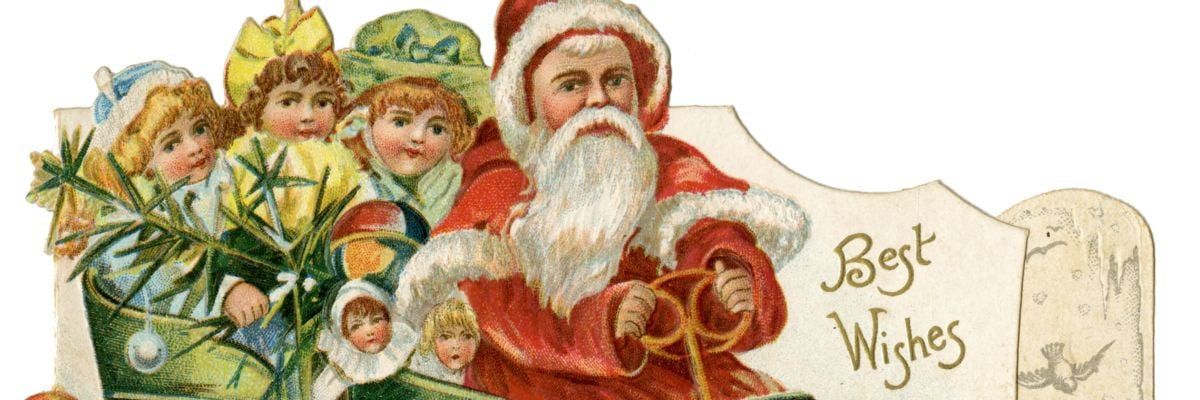
During my time as a pro-life evangelist, the organization I worked with was equally composed of Catholics and Protestants. At one of our December events, I asked a Protestant co-worker what she planned to do for Christmas.
“I don’t celebrate Christmas,” she answered.
“Oh? Why is that?”
She continued in a simple, matter-of-fact tone: “Because celebrating Christmas is not in the Bible.” Every other Protestant on our team still celebrated Christmas, but this young woman’s opposition to Christmas reminded me of the very first Protestants.
Throughout most of Church history, Christians did not exchange gifts on December 25. Instead, they celebrated the Mass dedicated to Christ’s birth (or “Christ-mass”). Gifts would be given on December 6, the feast day of the fourth-century bishop St. Nicholas, who was known for his extraordinary generosity. (This did not include leaving toys in poor children’s shoes—European parents celebrated that tradition much later on “St. Nicholas Day.”)
The earliest biographer of St. Nicholas tells us that the plotting and envy of the devil had driven the saint’s God-loving neighbor into poverty. This man was now so poor that he could not afford a dowry for his daughters to be married. As a last resort, the man decided to send them to a brothel so at least they wouldn’t starve in the absence of a husband to provide for them after his passing.
Fortunately, Nicholas took pity on him and remembered, among other Old Testament scriptures, Proverbs 24:11: “Rescue those who are being taken away to death; hold back those who are stumbling to the slaughter.” He then hurled three bags of gold through an open window of the man’s home, and the girls were married shortly thereafter. For the next few centuries, Nicholas was celebrated as a model of Christian care for the poor and became one of the most popular patron saints of the medieval period.
The Protestant Reformers, however, rejected veneration of saints like Nicholas and abolished the use of the traditional liturgical calendar. Philip Melancthon went so far as to say, “The bishops, theologians, and monks applaud these monstrous and wicked stories [about the saints] . . . because they aid them to their daily bread.”
Some of the Reformers didn’t even celebrate solemnities about Christ. For example, when John Calvin saw that an unusually large crowd had gathered to hear his sermon on Christmas day, he told them:
If you think that Jesus Christ was born today, you are as crazed as wild beasts. For when you elevate one day alone for the purpose of worshiping God, you have just turned it into an idol. . . . No day is superior to another. It matters not whether we recall our Lord’s nativity on a Wednesday, Thursday, or some other day. But when we insist on establishing a service of worship based on our whim, we blaspheme God, and create an idol, though we have done it all in the name of God.
Martin Luther was not as antagonistic toward Catholic rituals as Calvin or Zwingli, and he sought to keep ones that lacked overly “popish” influences. When it came to the tradition of giving gifts on St. Nicholas Day (December 6), he suggested that Christians celebrate the gift of Christ himself and exchange gifts on Christmas instead.
Luther’s suggestion did not include any representation of St. Nicholas, who remained a popular part of the Christmas tradition, especially in the Netherlands, where he was known as Sinterklaas.
To explain how St. Nick “stuck around” in the English-speaking world, we must look to late medieval England and its celebration of “Father Christmas.” He was originally a metaphor, like “Lady Luck,” and had no culturally recognizable appearance. But after a while, Father Christmas came to be depicted as a jolly, bearded man in a green robe who brought good cheer and merriment to adults (rather than children) during the Christmas season.
In the seventeenth century, after the English Civil War, Puritans who objected to “high church” practices in the Church of England rose to power. They sought to abolish all aspects of Christmas, which they described as having “trappings of popery and rags of the beast.” In order to appease them, the popular imagination slowly merged the figure of St. Nicholas with England’s Father Christmas until the celebration of Christmas became focused on a jolly, bearded man in a robe who brought good cheer, merriment, and gifts on December 25.
In early nineteenth-century America, every December, the Dutch continued to celebrate the arrival of Sinterklaas, whom Washington Irving described in 1809 with the English equivalent of “Santa Claus” (though he looked like an overweight sailor dressed in green). The rest of what we associate with Santa Claus comes from a variety of sources, including the 1823 poem “A Visit from St. Nicholas” (or, as you probably know it, “The Night Before Christmas”), Harpers Weekly cartoonist Thomas Nast, and Coca-Cola advertisements—which ingrained into the American consciousness the image of a red- and white-robed, jolly bearded man with the goal of getting people, especially children, to drink soda during the winter months, when it wasn’t very popular.
And that, Virginia, is where “Santa Claus” began. However, the legacy of St. Nicholas doesn’t have to end there. Christmas can be a joyful time for Catholics to witness to our Protestant brethren, who would be shocked by Reformers who preferred “Bah, humbug” over “merry Christmas.” We can, for example:
- Show them that “graven images” are not sinful, but help us remember the heroes of our faith so we can imitate them. After all, the same Protestants who object to statues in Catholic churches usually have no objection to mangers that depict the Holy Family.
- Introduce them to saints like Nicholas, who help keep “Christ in Christmas” because, unlike Santa, they actually exist, and venerating them brings us closer to Christ. In the biography I cited earlier, the author says of Nicholas, “O the beneficial and beautiful purpose of all-blessed Nicholas! The care of his good-natured soul revealed in visible form a model of our savior Christ’s compassion toward us.”
- Help them overcome the idea that rituals are harmful to a faith that should be about a “relationship with God” by showing how their most important relationships are celebrated through rituals: Christmas services they get dressed up to attend, tree-lighting, gift-giving, and the singing of Christmas carols (which the Puritans once outlawed).
- Show that Tradition is not opposed to Scripture. No Christian follows a strict form of sola scriptura, because everyone comes to Scripture with at least some non-biblical traditions attached to it (the least of which is the tradition of which books belong in the Bible in the first place). Traditions that contradict the word of God are wrong, but not sacred and pious traditions the faithful have handed on to us through the centuries, even if they aren’t explicitly found in Scripture. This includes the pious tradition of joyfully exclaiming, “Merry Christmas”—not just for one day, but for an entire season that celebrates the birth of our savior, Jesus Christ.



